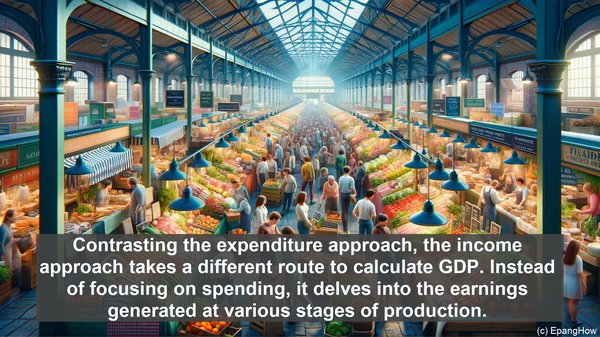Introduction: The Essence of GDP Calculation
Greetings, ladies and gentlemen! Before we embark on our exploration of the expenditure and income approaches, let’s take a moment to understand the fundamental concept they revolve around: GDP, or Gross Domestic Product. In essence, GDP is a measure of a nation’s economic output, encompassing all the goods and services produced within its borders over a specific period. It serves as a vital indicator of a country’s economic health, offering insights into its growth, productivity, and overall well-being.
The Expenditure Approach: Tracking Consumption, Investment, and More
Now, let’s shift our focus to the expenditure approach. As the name suggests, this method revolves around tracking the various components of expenditure within an economy. It breaks down the GDP calculation into four main categories: consumption, investment, government spending, and net exports. By summing up the expenditure in each of these areas, we arrive at the total GDP figure. This approach is often likened to a ‘spending’ perspective, as it emphasizes the final use of goods and services within the economy.
The Income Approach: Unraveling the Earnings Trail
Contrasting the expenditure approach, the income approach takes a different route to calculate GDP. Instead of focusing on spending, it delves into the earnings generated at various stages of production. This method considers the income earned by individuals and businesses in the form of wages, rents, profits, and more. By summing up these income streams, we arrive at the GDP figure. In essence, the income approach can be seen as a ‘earning’ perspective, as it traces the income generated by the production and sale of goods and services.
The Interplay: Complementary Perspectives
While the expenditure and income approaches may seem distinct, they are, in fact, two sides of the same coin. They offer complementary perspectives on an economy’s activity, each shedding light on different aspects. For instance, the expenditure approach provides insights into the final demand for goods and services, reflecting consumer behavior and investment trends. On the other hand, the income approach offers a glimpse into the earnings generated by economic activity, highlighting the distribution of income and the overall productivity of the economy.

The Significance: Beyond Numbers
Beyond their technicalities, both the expenditure and income approaches hold immense significance. They serve as tools for policymakers, economists, and analysts, offering a comprehensive view of an economy’s dynamics. By analyzing the components of GDP, policymakers can identify areas of strength and weakness, formulating strategies to foster growth and stability. Moreover, GDP figures, derived from these approaches, are closely watched by financial markets, as they provide insights into a nation’s economic performance, influencing investment decisions and market sentiment.

